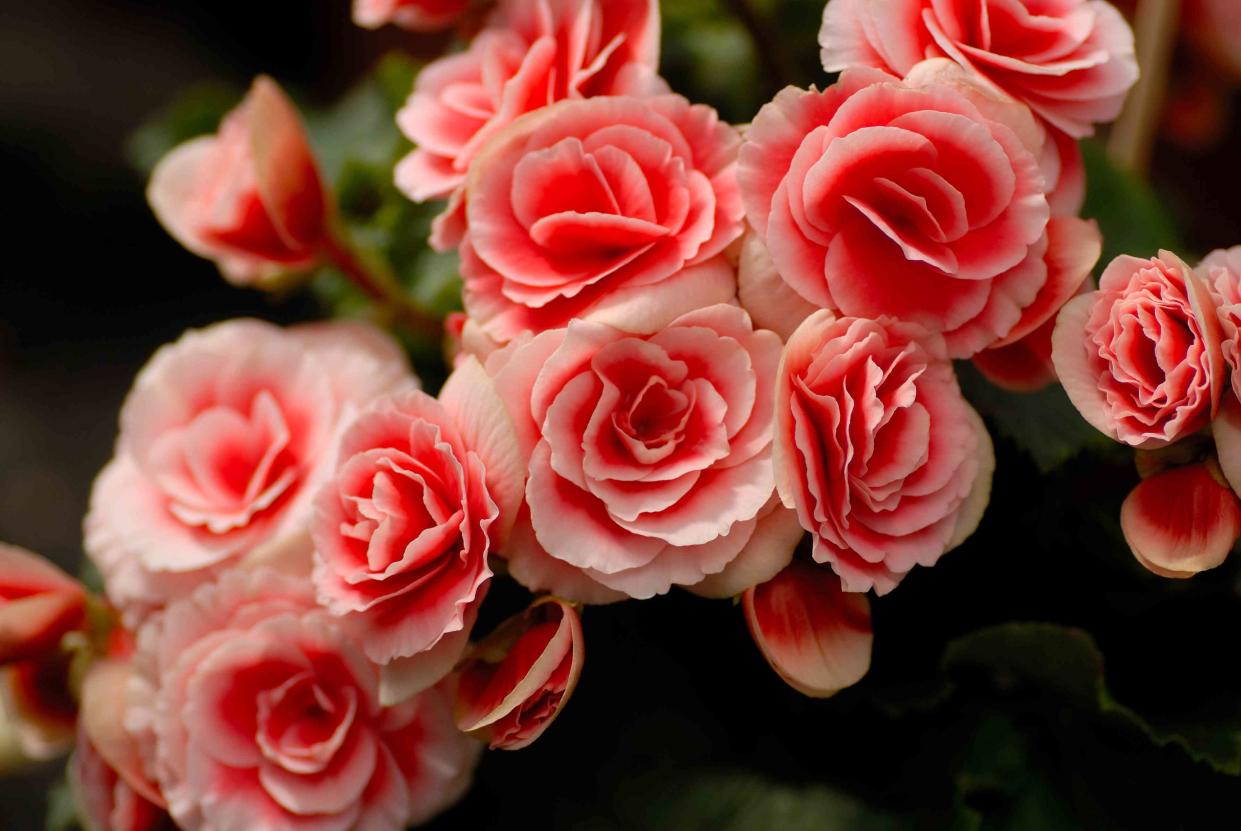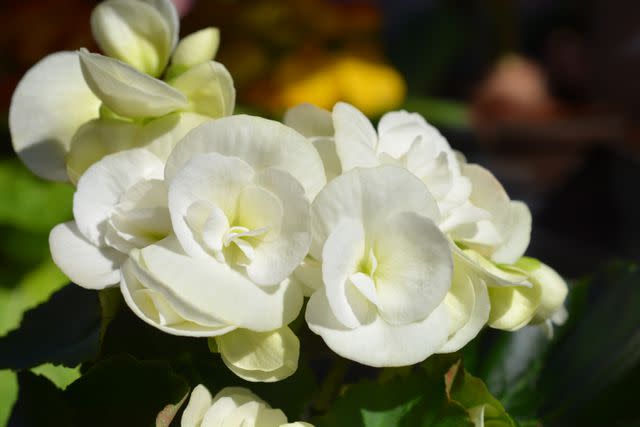How to Grow and Care for Elatior Begonia and Instantly Brighten Any Space

adel66 / Getty Images
Elatior begonia (Begonia x hiemalis) is a fast-growing flowering plant with fleshy, heart-shaped green foliage and blossoms that come in vibrant yellow, orange, red, pink, coral, and white colors. This hybrid category of begonias was created by crossing tuberous begonia with a wax begonia, and is a close relative of the rex begonia.
Begonias in this group were originally bred as annuals to bloom during the winter season, and mostly designated as houseplants. However, the elatior begonia is a perennial plant capable of blooming all year long, and in addition to growing indoors, can make an excellent addition to an outdoor container garden or window box.
Botanical Name | Begonia x hiemalis |
Common Name | Elatior begonia |
Plant Type | Perennial |
Mature Size | 12-18 in. tall, 1-2 ft. wide |
Sun Exposure | Indirect light, partial sun |
Soil Type | Well-drained, sandy loam |
Bloom Time | Winter, but can vary |
Flower Color | Yellow, red, pink, orange, coral, and white |
USDA Hardiness Zones | 9-11 |
Native Area | South and Central America, Africa, and southern Asia |
Toxicity | Toxic to people and pets1 |
Elatior Begonia Care
Elatior begonias are generally not difficult to grow or maintain, but it's important to know what conditions they thrive in.
Plant in a well-drained, rich potting mix.
Typically grown as an annual, elatior begonias can survive outside in areas where temperatures range from 50 to 75 degrees Fahrenheit.
Need cool temperatures and short days in order to bloom.
Stakes may be required to support your elatior begonia plant's abundant blooms.

Nahhan / Getty Images
Nahhan / Getty ImagesLight
Elatior begonia plants are commonly grown as indoor houseplants, where they thrive in bright, indirect light. Choose an area in your home for your elatior begonia where it will not be exposed to direct sunlight, which will burn and damage leaves and blossoms, as well as make them grow too leggy.
When growing elatior begonia outdoors, be sure to plant it in a shaded area to keep its delicate foliage from being scalded by the sun.
Soil
Elatior begonias have fibrous roots that require good anchoring in order to support the heavy blossoms that grow on the plant. The best soil for them is a high-quality, well-draining soil consisting of potting soil and perlite.
Water
Allow the top inch of soil to dry out before watering your elatior begonia. Depending on the environment, you should water the plant about once every five to seven days.
Temperature and Humidity
All types of begonias are sensitive to frost and low temperatures, and thrive in environments with temperatures between 50 and 75 degrees Fahrenheit.
As plant that's native to moist subtropical and tropical climates, elatior begonias need average to warm humidity levels, ideally between 40 and 60 percent.
Fertilizer
During the growing season—from spring to the first frosts of fall—fertilize with a water-soluble plant fertilizer every two weeks. To do so, dilute half a teaspoon of fertilizer in one gallon of water.
Pruning
If your elatior begonia is tall and leggy, pruning can help it grow into a better shape. Using your fingers of a clean pair of pruning shears, prune away any old growth. Pinch or cut above a node, found below each leaf. The elatior begonia plant will then produce side-shoots and grow into a fuller, bushier plant.
Propagating
Begonias, including elatior begonias, are easily propagated from single leaf cuttings. While you can easily propagate begonias throughout the year, the best time to do so is in the spring, before they've hit their summer blooming season.
Select a vibrant, healthy leaf for your cutting. Make sure it has a woody stem.
Take a leaf cutting using a small, sharp knife or clean pair of pruning shears, careful to leave at least one inch of the stem that connects the leaf to the rest of the plant.
Take your cutting and press the stem into soil, gently covering it.
Cover the newly planted cutting with a plastic bag to create a humid environment and place in a well-lit and warm spot.
Mist the cutting every few days. Within six to eight weeks, your elatior begonias will have developed roots and be ready to be planted.
Potting and Repotting Elatior Begonias
Elatior begonias grow very well in pots, both indoors and outdoors. To prevent root rot and other diseases, it's important to choose a pot that has drainage holes.
As its fibrous roots grow, the elatior begonia will occasionally need to be repotted to give it more room. To repot, gently lift the roots and place into a new, larger pot with fresh, well-draining potting soil and then water the plant.
Common Pests & Plant Diseases
Similar to other houseplants, elatior begonias can become afflicted by various pests, including aphids, caterpillars, spider mites, thrips, and whiteflies. Apply neem oil or insecticidal soap to get rid of them.
Diseases to watch out for include botrytis, fusarium, powdery mildew, and rhizoctonia. The best way to prevent these diseases from affecting your elatior begonias is to avoid overwatering and ensure it gets plenty of sunlight.
How to Get Elatior Begonias to Bloom
The best part of growing elatior begonias are the abundant, showy, and long-lasting flowers that they produce, which grow together in clusters and come in an array of different colors.
Elatior begonias are photoperiod bloomers, meaning their bloom is stimulated by the number of hours of light they receive. To induce flowering, you can create a short-day environment in your home by using blackout curtains so that the plants experience long "nights" of 12 hours or more. This will encourage the plant to bulk up growth.
To promote more blooming, be sure to pinch away old or dead flowerheads.
Common Problems With Elatior Begonias
Elatior begonias are widely known as being a low-maintenance flowering plant. However, it's important to make sure the plant is not being overwatered or exposed to direct sunlight—or too little sunlight—which can affect their growth and make them more prone to diseases.
Frequently Asked Questions
Is elatior begonia an indoor plant?
Elatior begonia plants are commonly grown as indoor houseplants, but can also survive outdoors.
What is the lifespan of an elatior begonia?
Elatior begonias, like most begonias, can live as long as two to three years when properly cared for.
Can I plant my potted begonia outside?
You can plant potted begonias outside in warm temperatures only, ideally between 60 and 80 degrees Fahrenheit. Begonias are a tropical plant and are sensitive to frost and low temperatures.
Read Next: How to Grow and Care for Begonia Maculata
Read the original article on The Spruce.

